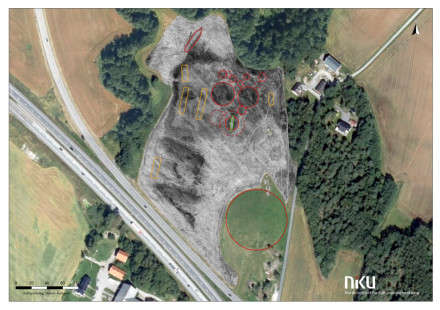History
In 2018 archaeologists armed with a motorized high resolution georadar have found a Viking ship and a large number of burial mounds and longhouses in Østfold County in Norway.

The discoveries were made by the archaeologists Lars Gustavsen and Erich Nau from the Norwegian Institute for Cultural Heritage Research (NIKU) with technology developed by the Ludwig Boltzmann Institute for Archaeological Prospection and Virtual Archaeology (LBI ArchPro).
The Viking ship find is just below the topsoil, at a depth of approximately 50 cm initially buried in a burial mound. The digital data visualisations reveal a large and well-defined 20 m long ship-shaped structure. The data indicated that the lower part of the ship is still preserved.
The sensational find is located at Viksletta right next to the monumental Jell Mound in Østfold County, Norway.
Description
Type: Viking longschip,drakar
Built: Western Norway
Propulsion: oar and sail
Rigging: square rigged
Length: 20 m

Status
Trial trench survey 2019
In 2019, a small study was conducted in which parts of the keel were found. Dendro analyzes date the grave between the late 8th to the early 10th century.
It is interesting that the wood sample from the keel is very similar to samples from Oseberg and one of the small boats from Gokstad. Which indicates that the wood comes from the same area in Southwest Norway, says project leader Rødsrud.
During the small-scale study, it was established that degradation takes place at a rapid pace. The reason is that in the past 70 years a lot of damage has been caused by drainage and plowing and that the wood has been strongly affected by fungi. Leaving it in situ is therefore not an option.
Excavation summer 2020
A unique excavation in Norway will commence in June 2020. The Norwegian government has allocated NOK 15.6 million for the excavation of a Viking shipgrave discovered in 2018.
There are very few surviving Viking ships in the world, and any new knowledge about them contributes to a better understanding of society in the Viking era, says director Håkon Glørstad of the Museum of Cultural History responsible for the excavation.
It has been more than a hundred years since the last archaeological excavation of a ship's grave, and with modern excavation methods and technology, we can obtain much more information than from the previous two excavations, says Glørstad. The excavation is expected to take five months.
References
- NIKU.
The Gjellestad Ship. - Kulturhistorisk museum.
Nå skal Gjellestadskipet graves ut.